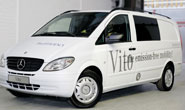
By Bob Difley
Mercedes-Benz this week debuted an electric battery-powered version of its Vito commercial van, stating that it will have an average range of more than 80 miles and a top speed of 50 mph.
The van was unveiled at a meeting of the EU Competitiveness Council in Spain, where it was also announced that the German government is to provide funding towards a major trial of the new technology.
Mercedes-Benz said that as part of the trial it plans to provide more than 100 electric vans to 20 customers, including fleet operators and public sector bodies.
A spokesman for the company in the UK told BusinessGreen.com that the firm hoped to begin trialling the vehicle in the UK by the autumn. “We’ve had considerable interest from corporate customers who want to get involved in a trial,” he said, adding that the vehicle was on track for a commercial launch before 2012.
Mercedes-Benz said it was planning to deliver 2,000 models during the first phase of production. It added that the electric motor would be powered by a Lithium-ion battery with a peak output of 90kW.
This is another of those “delivery van” sized electric vehicles that is an incremental step toward a small Class B RV when the technology filters down to RV manufacturers. The success of electric vehicles of this type, and of those larger ones that follow, will be the further development of battteries to provide a longer range, andthe availability of charging stations with the frequency of gas stations. The ability to recharge the battery from an onboard RV generator while driving to extend the range and by plugging in to your campground power at night to recharge will also bring it closer to mainstream acceptance.
Check out my new eBook, BOONDOCKING: Finding the Perfect Campsite on America’s Public Lands.




Pingback: compare 3d tv tv prices wwwcompare3dtvcouk
Pingback: url
Pingback: Homepage
Car And Van Insurance
Obviously designed as a commercial fleet vehicle where you would have a
series of short runs.
————
James
ryantyler111
o A very smart and diplomatic answer. It’s really appreciable and general.
**********
ryantyler111
Compare Van Insurance
Liz Bard
At my last job before quitting to return to college (didn’t finish, but there is always next year), my former boss used a manual wheelchair. The office had people from mainly my generation (born in early 50’s), but I had friends also from another office who were of the younger generation (post Vietnam) who did not understand why we should still consider going to the moon or Mars probes, etc. One of the advantages of going to the moon has been lighterweight bicycles (we pointed that out to one serious bike rider, who freaked when we showed them pictures of what we had in the 50’s – gears? those were our legs and how fast we could pedal and the weight). Going into space also meant lighterweight wheelchairs and solar panels were first thought of when they were in space to power all the gismos.
We are getting there. I am keeping an eye out on these battery rigs since I still have friends in wheelchairs, one of which has a super heavy battery. Her poor husband had to push it once when the battery malfunctioned (it was new – go figure). They don’t have available battery rechargers in town or at shopping malls for some of these heavy wheelchairs without adding extra wiring.
I have faith that someday we will be able to travel places in a smaller RV. I cannot wait to see what else Mercedes Benz comes out with. Since GM eliminated the Saturn and Opel brands (had a 72 Opel Manta with my husband for 5 years and we are on our 7th Saturn since 1994 – just had to get into the bigger/taller vehicles as the knees refused to go down to get into the lower vechicles), I am looking to Mercedes Benz – either one built in Alabama or Germany (my preference) when I have to take my present Saturn to the bone yard – but hopefully not for many years.
Kriilin Namek
Interesting article Bob. What one needs to do is mate that up with a kick-butt generator much like the Chevy Volt. Anthropogenic Global Warming, Peak Oil, pshaw, I see other advantages to this setup
1) You’ve got a great electrical system, perfect for boondocking, or if Aerosmith drops in for an impromptu party (it COULD happen)
2) The generator can run at a constant RPM, unlike if the ICE is directly driving the vehicle, resulting in better efficiency. Plus since its “filling a tank” it doesn’t need to be as large because its not being used for peak power (acceleration). It just needs to refill the tank at the same speed it drains on average, thus less HP than a conventional ICE, again more efficient.
3) Terrific engine braking. If your electric motor is 300HP driving, it is a 300HP brake (assuming you can absorb/dispel electricity that fast), converting kinetic energy into 90+% electricity instead of ~100 % heat, which conventional brakes do now. Plus if that downgrade is REALLY steep, you still have the conventional brakes on top.
4) Torque baby! (Need I say more?)
Frank Howard
Obviously designed as a commercial fleet vehicle where you would have a
series of short runs. At the end of its shift it would be plugged in for the next day.
This is done with lift trucks in factories and golf carts at golf courses. Remember,
house power is as clean as the population is willing to pay for it. Personally, I cannot ever see an electrical vehicle as an RV vehicle as there is too much load.
Diesel-electric train technology is a possibility but only as a means to gain low speed torque and perhaps better fuel economy.
Bob Difley
Joe says “They are not designed for people who actually want to travel somewhere.”
I am fully aware that the MB delivery van is not quite ready for a Class B RV, but it is a step along the road to electric RVs. Already certain states and companies are installing electrical vehicle recharging stations, and as EVs catch on, there is no doubt that the oil companies will be installing charging stations in their gas stations. And the latest technology is able to charge an EV battery up to 80% in 15 minutes. In fact, it might even extend the life of the battery to not charge it to 100%. And if you look at the Prius record, the battery is claimed to last the life of the car–more than 150,000 miles (in fact lab tests have shown the battery to have no deterioration even after 180,000 miles, and no Prius battery has yet needed to be replaced because of wearing out). Even the cost of a replacement battery is down to about $3,000. If it lasted 150,000 miles that’s 2 cents a mile. Not only that, but the second generation battery for the Prius is 15% smaller, 25% lighter, and has 35% more power. If the technology continues to improve, by the time RV manufacturers get around to trying the EV model, there should be even better figures for mileage between charges, length of time to charge, and choices where to recharge. How often do you drive over 150 miles in a day? That distance would require you to stop once at about half way to charge (how about over lunch) then again in your campground overnight. Wouldn’t that be worth the inconvenience for being able to “fill up” for pennies per gallon on recharging? If you were boondocking, you could recharge with solar panels or wind.
But, I agree, it’s not there yet . . . but getting closer.
Bob
Tom Hargreaves
What with all the discoveries and engineering advances in Lithium-ion and Lithium-air batteries, fuel cells that don’t require Platinum to convert Hydrogen, new low power techniques for extracting Hydrogen from water, the recently announced Bloom Box that is already in use powering parts of major companies, along with about-time vehicle improvements, I am looking forward to long range, comfortable RVs that I can boondock in QUIETLY in the next few years.
Whether or not there is a climate issue, we do know that the stores of hydrocarbon fuels are limited (probably less than 100 years for the easy-and-cheap-to-extract stuff) and advances in electric, hydrogen, and energy conversion will benefit us in the long run (seven billion people and climbing use a lot of energy). Might as well create some jobs in new technology sectors and get the transition going. The discoveries and advances are happening whether certain people want them to or not. I realize that change can be pretty frightening, but change is necessary if our children and their children are to have a great future.
Thanks for keeping us posted on advances that will make boondocking even more pleasant in the future!
Tom
Joe
Interesting that a guy so into boondocking is highlighting vehicles where you have to drive from plug to plug every hour and a half.
All of these delivery sized vehicles are designed to make short trips away from and back to a central point (deliveries!). They are not designed for people who actually want to travel somewhere.
Rob
–??? 50% coal in US.
Ronald
Umm – what’s the problem with the Germans doing the research? So they get ahead of us in the long run? At least its not cost you anything!
Glad yhour keeping us up-to-date on what other countries are doing as we still think a 100 year old internal combustion engine is the leading edge of technology!
gmas
Bob.. while its a great looking vehicle… it is less effecent than the diesel powered one.
It is the recharge time and power company that someone keeps forgetting when they talk about all this GREAT effecency… ahhhh not so… as you have to keep in mind the amount of energy that it takes to make it.. run it… and recharge it… and its really not a 0 emission vehicle either as it take something back over yonder to make ye old power plant move the electrons… and that is fuel… something burning or turning…
So all this hype over 0 emission elect cars… is just so much wolf in sheeps underware… just more junk … (when it takes 1.5 times as much energy to recharge the thing than it uses to go with… how effecent is that?…. and lets not interview the poor guy who went 81 miles and has to push the thing home.. I don’t think autoclub is going to have a recharge kit on board .. but hey they all fit in the back of the tow truck… I rec-on… Oh and what is the cost of replacement bats? wow $11,000 bux for the toyota hybrid… ouch that can by a lot of gas hmmm
As they say… thanks for playing the game… and nice try… 🙂